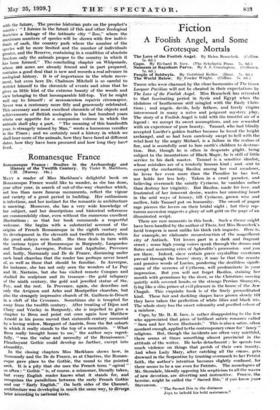Romanesque France
Romanesque France : Studies in the Archaeology and History of the Twelfth Century. By Violet R. Markham,
C.H. (Murray. 18s.)
MANY a reader of Miss Markham's delightful book on Romanesque France would like to wander, as she has done, year after year, in search of out-of-the-way churches which, not less than more famous monuments, reflect the vigour and variety of a great period in building. Her enthusiasm is infectious, and her instinct for the romantic in architecture is unerring. Moreover, she has a very wide knowledge of her subject, and her descriptions and historical references are commendably clear, even without the numerous excellent illustrations ; so that her book commands a respectful welcome. She begins with a substantial account of the origins of French Romanesque in the eighth century and its development in the eleventh and twelfth centuries, when the great abbeys were built. She then deals in turn with the various types of Romanesque in Burgundy, Languedoc and Toulouse, Auvergne, Poitou and Aquitaine, Provence and, lastly, Normandy and Re de France, discussing under each head churches that the reader has perhaps never heard of, as well as those that should be familiar. In Auvergne, for instance, she has not only seen the wonders of Le Puy and St. Nectaire, but she has visited remote Conques and studied its sculpture and its treasure—the gold reliquary of the ninth century, the gold and jewelled statue of Ste. Foy, and the rest. In Provence, again, she describes not only the Avignon and Arles and Montpellier churches, but also the strangely impressive church of St. Guilhem-le-Desert in a cleft of the Cevennes. Sometimes she is tempted far away from the twelfth century. Aftex treating of Dijon and Cluny and Vezclay in Burgundy, she is impelled to give a chapter to Brou and point out once again how Matthew Arnold in his poem moved that sixteenth century memorial by a loving widow, Margaret of Austria, from the fiat suburb hi which it really stands to the top of a mountain. " What Brou really brought home to me," the author says regret- fully, " was the value and necessity of the Renaissance." Flamboyant Gothic could develop no further, except into absurdity.
In the closing chapters Miss Markham shows how, in Normandy and the Ile de France, as at Chartres, the Roman- esque gave place to the Gothic, the round to the pointed arch. It • is a pity that she uses the French term " ogival " so often : " Gothic " is, of course, a misnomer, literally taken, but every English reader knows what it stands for, and recognizes, the parallelism between the early French Gothic ' and our " Early English." On both sides of the Channel, architecture was developing in much the same way, to diverge later iceording-to.national taste.








































 Previous page
Previous page